There was a time in the U.S. when driving was an activity in and of itself. Teenagers would cruise the main drag with their friends and dates. Families would pack the car for Sunday drives in the countryside. But around the 1970s, a shift happened. People started to see driving as more of a utility than a hobby or a leisure activity.
Fast forward to today. For many people, driving is necessary as a means to get to and from work, transport family members, and shop for groceries and other necessities.
But from long commutes to gridlocked traffic to carbon footprints, there aren’t many positive things we associate with driving anymore. In fact, many Californians think driving sucks — and are driving less and less because of it.
Many Californians report that they drive less today than they did five years ago — but we wanted to learn more about why. It turns out, their reasons are varied. Here’s what we learned.
39.1% of Californians Avoid the Road Because of Poor Drivers
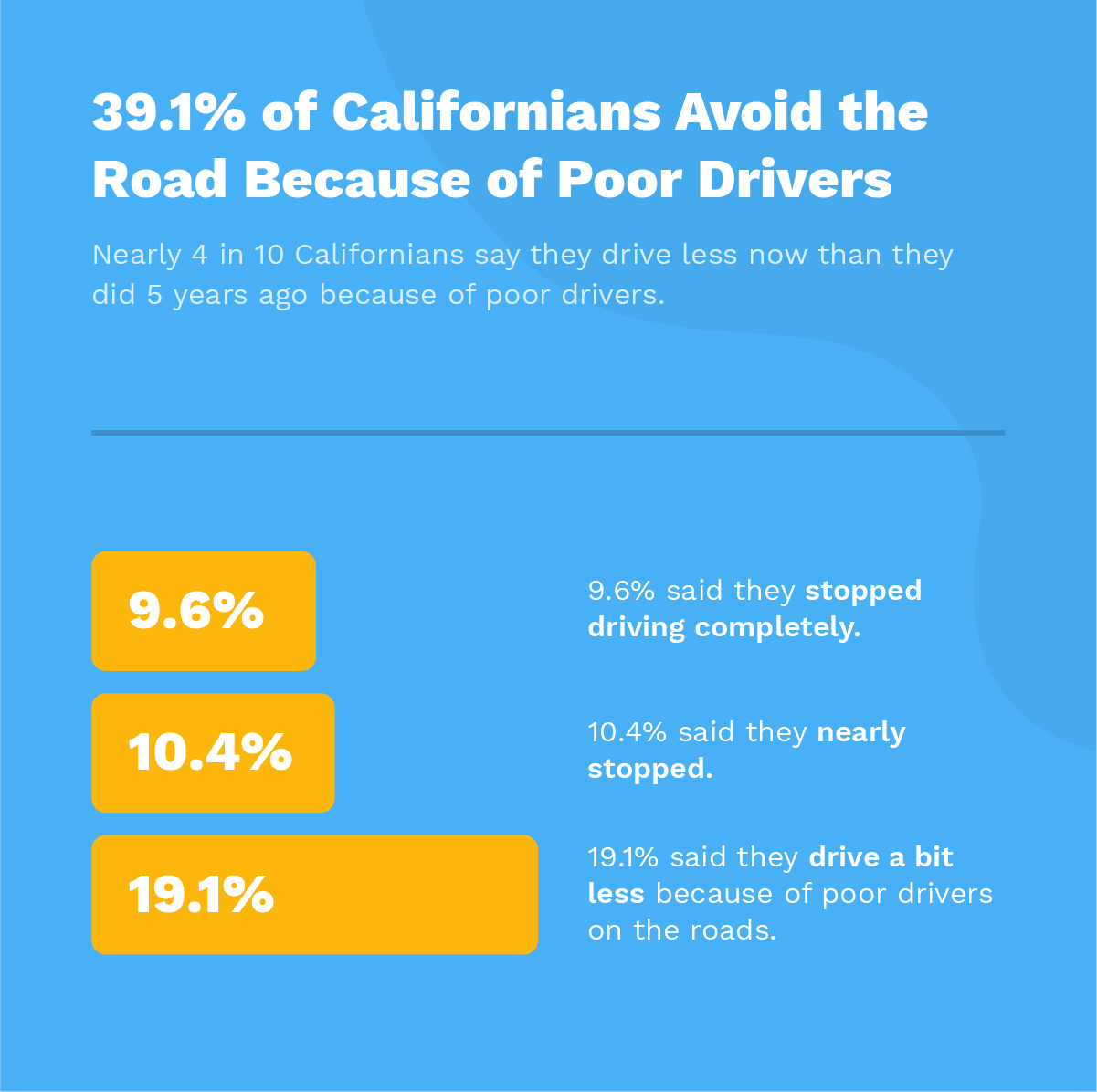
No surprise here. Everyone who’s driven in California (especially during rush hour) has a story about being forced to share the road with an aggressive, road ragey, or just bad driver.
In our survey, we found that 39.1% of Californians drive less now than they did five years ago because of poor drivers. Of them,
- 9.6% said they stopped driving completely.
- 10.4% said they nearly stopped.
- 19.1% said they drive a bit less because of poor drivers on the roads.
Poor drivers are more of an issue for men and younger drivers.
- 41% of men report driving less because of bad drivers, compared to 37.4% of women
46.4% of young drivers drive less because of poor drivers vs. 34% of older drivers
Traffic school can help you keep a clean driving record, prevent insurance increases, and more!
39% of Californians Drive Less Because of Bad Road Conditions
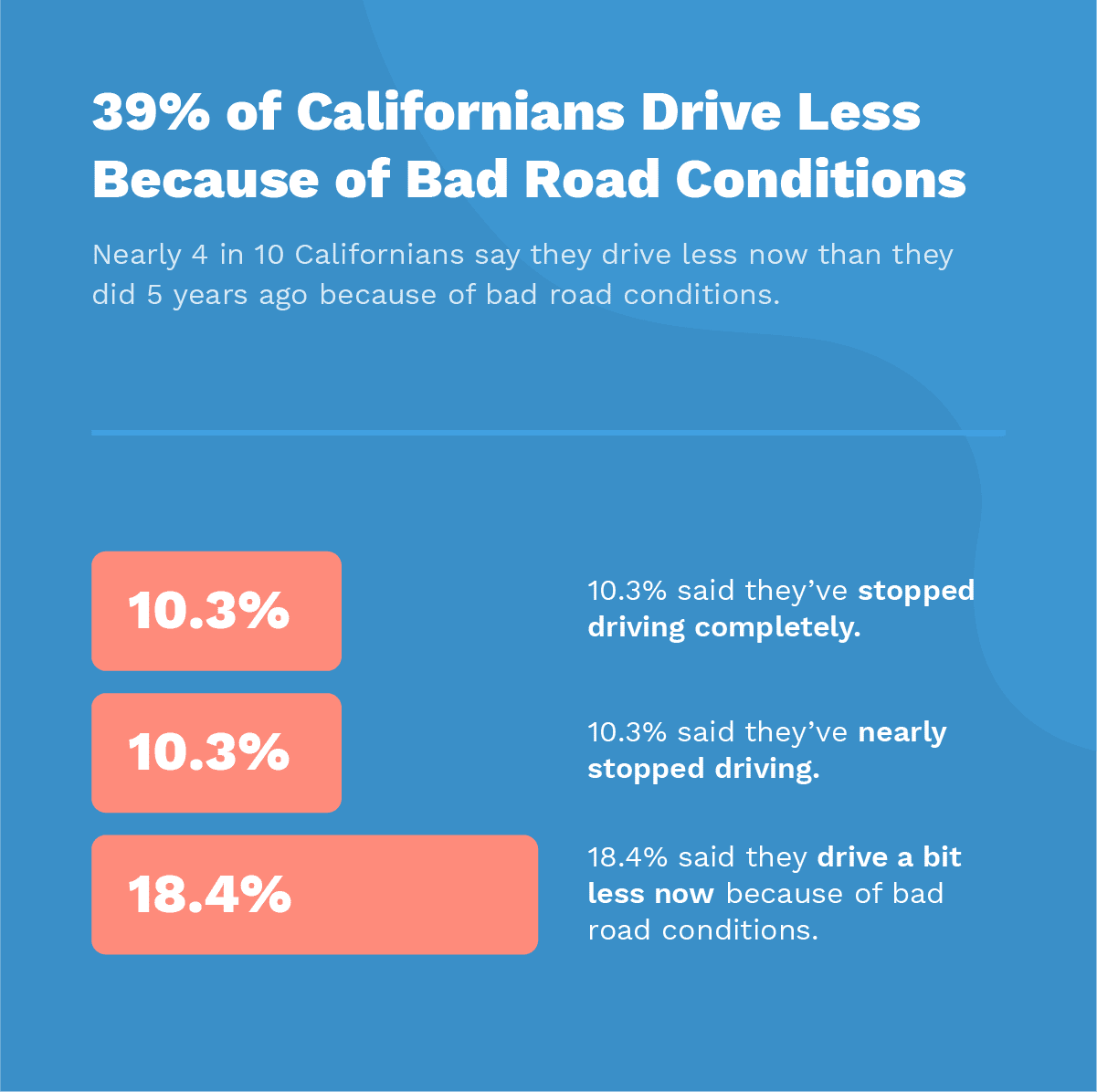
The American Society of Civil Engineers (ASCE) compiles yearly “report cards” on American infrastructure, including roads, bridges, highways, and more. In 2017, the most recent year that data was released, the ASCE found the nation’s infrastructure averaged a D+ grade, meaning infrastructure conditions were “mostly below standard,” showing “significant deterioration,” and “strong risk of failure.”
In California, the state of the roads is making many drivers choose to stay off them. 39% of California drivers say they drive less today than they did five years ago because of bad road conditions. Of them,
- 10.3% said they’ve stopped driving completely.
- Another 10.3% said they’ve nearly stopped driving.
- 18.4% said they drive a bit less now because of bad road conditions.
This is another issue that seems to be more important to men — 43.6% of them say they drive less because of bad roads, compared to just 35% of women.
Young people are also much more likely to drive less because of this issue — 47.3% of them, versus just 33.2% of older drivers.
54.9% of Californians Avoid Driving Because of Traffic
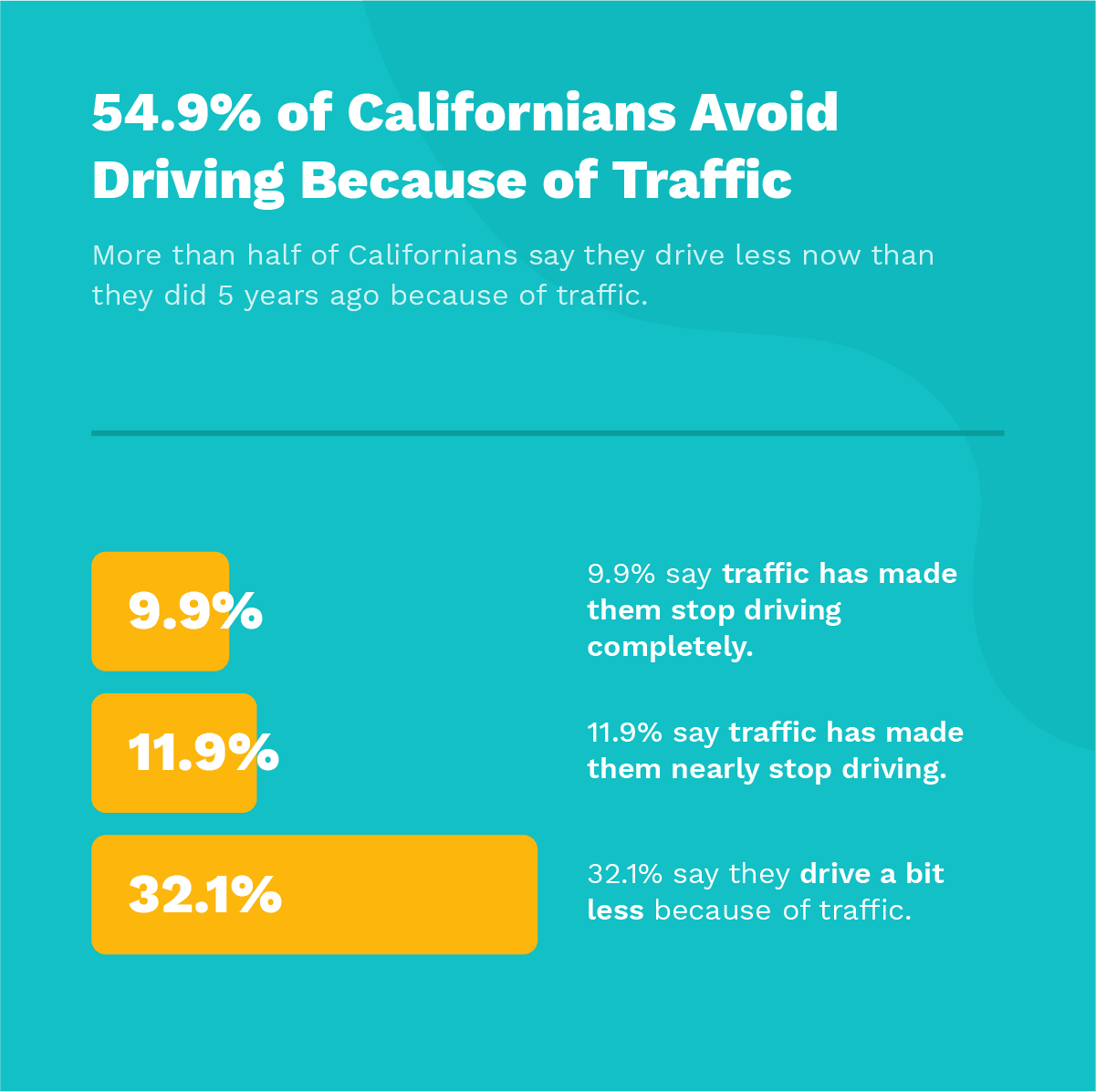
California is known for its traffic. In fact, the state consistently ranks among the worst in the country for traffic and commute times. According to Overdrive, 87% of California’s urban highways experience regular traffic congestion — nearly double the national average of 47%.
So it should come as no surprise that more than half of the state’s drivers — 54.9% — say they drive less now than they did five years ago because of traffic. Of those,
- 9.9% say traffic has made them stop driving completely.
- 11.9% say traffic has made them nearly stop driving.
- 32.1% say they drive a bit less because of traffic.
Men and women were pretty equally likely to stop driving due to traffic, but young people are much more affected by this than older drivers — 60.2% of young drivers say traffic has caused them to drive less, compared to 49.5% of older drivers.
California Drivers Are Changing their Habits Because of their Environmental Impact
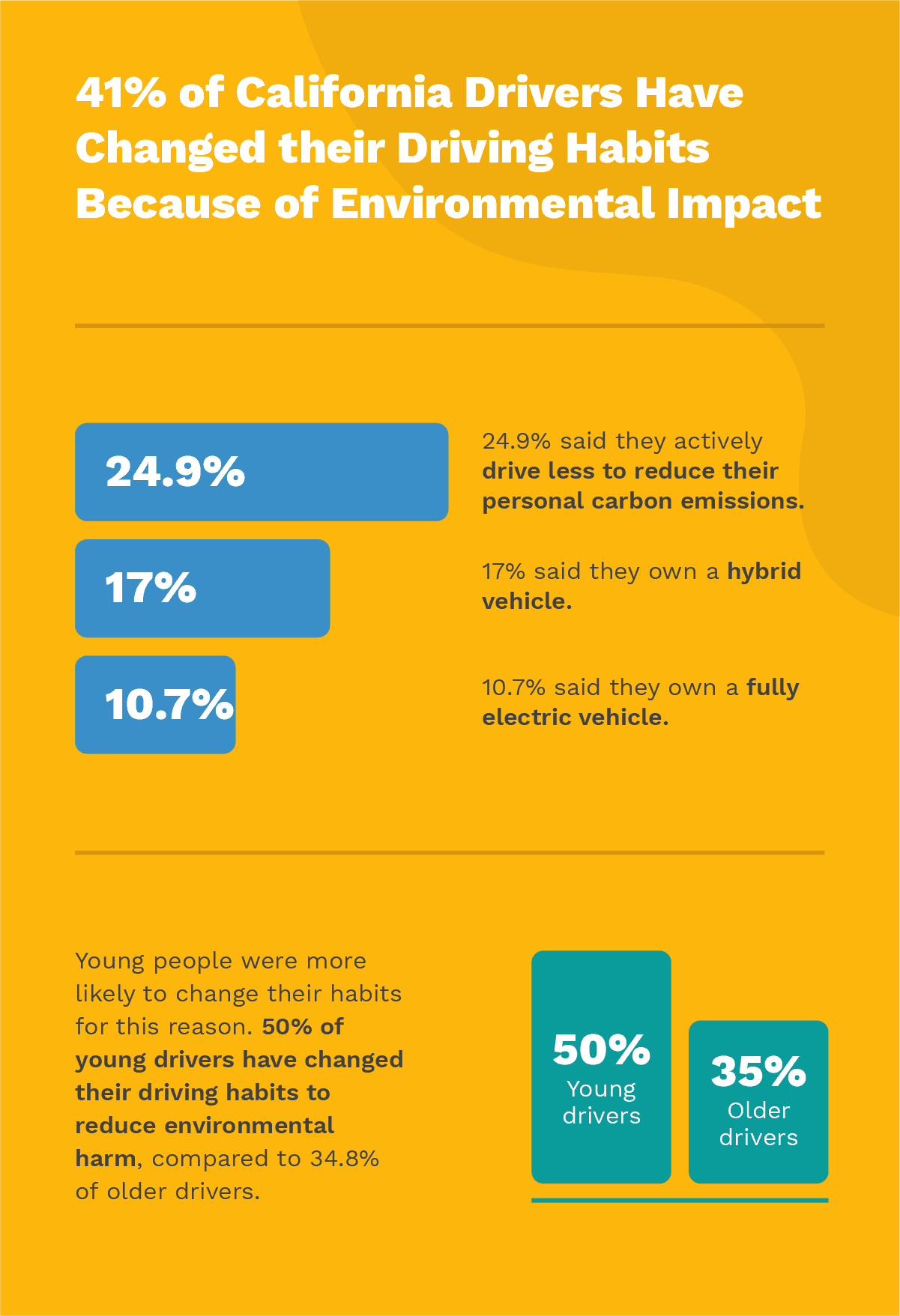
We know that passenger vehicles and gas production are some of the top contributors to carbon emissions in developed countries. But what we’re learning is that many drivers in California are willing to change their driving habits to reduce their environmental impact.
- 24.9% said they actively drive less to reduce their personal carbon emissions.
- 17% said they own a hybrid vehicle.
- 10.7% said they own a fully electric vehicle.
Unsurprisingly, environmental impact is more important to younger drivers than older ones. A whopping 50% of young drivers said they’ve adjusted their driving habits to reduce their environmental impact, versus just 34.75% of older drivers.
More than a Quarter of California Drivers Are Worried About AI-Powered and Autonomous Vehicles
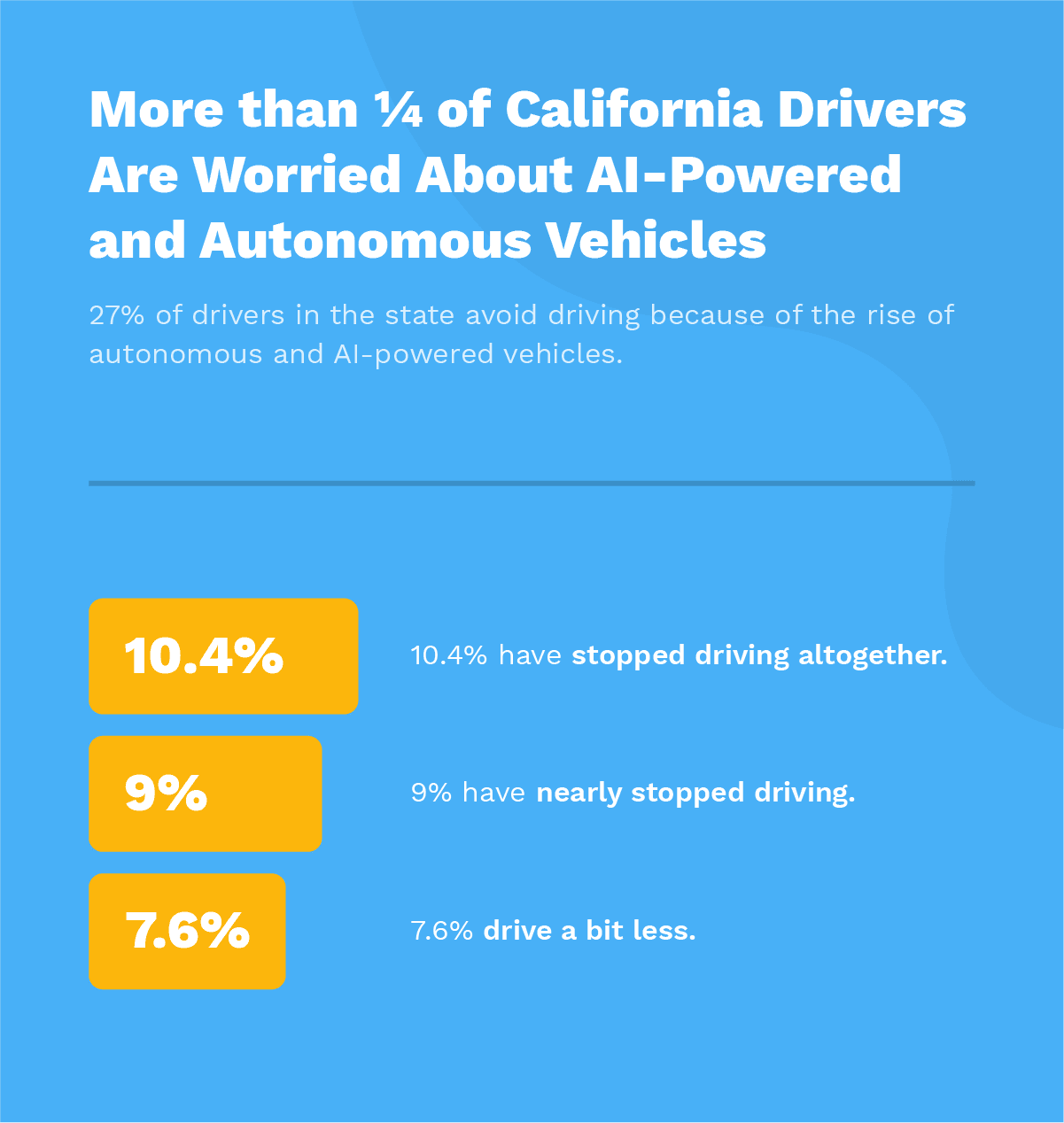
AI-powered and autonomous (or “self-driving”) vehicles have made some scary headlines in the last few years — particularly when they’re involved in crashes. The reality, though, is that more and more of those cars are on the roads — and companies like delivery and rideshare services are looking for ways to incorporate self-driving vehicles in their fleets.
Our study shows California drivers are nervous about this — 27% of them have reduced their driving compared to five years ago because they’re worried about the rise of AI-powered and autonomous vehicles. We also found that Californians who are worried about self-driving vehicles are more likely to stop driving completely than to just reduce their time spent on the roads.
- 10.4% have stopped driving altogether.
- 9% have nearly stopped driving.
- 7.6% drive a bit less.
Once again, men are much more likely to take this issue seriously. 34.4% of men said they’re driving less because of the rise of autonomous and AI-powered vehicles, compared to just 20.5% of women.
Many Californians Drive Less Because of Expenses, Logistics, and Car Availability

It’s no secret that a dollar just doesn’t go as far as it once did. Amid rising inflation, higher costs of living, and stagnant wages, many Californians are driving less to save money.
Altogether, 47.2% said they’re driving less now than they did five years ago because of the costs of driving and owning a car.
- 27.9% drive less because of high gas prices.
- 16% drive less because of the cost of cars.
- 15.3% drive less because of the price of auto insurance.
- 19% drive less because of the costs of maintaining a vehicle.
High costs are especially impacting young people. 51.5% of young drivers said they drive less now than five years ago because of the cost of driving, compared to 44.2% of older drivers.
Finding Places to Store a Car Can Be Tough in California
One barrier to driving that many Californians face is finding a place to keep a car. California has a high number of people living in apartments and condos that don’t have driveways or garages. Nearly a third of the state’s drives — 28.7% — said they drive less today than they did five years ago due to issues storing their car. Of those,
- 19.1% said they struggle to find public parking options.
- 17% said they don’t have anywhere to keep their car at night.
Car Availability Is Affecting California Drivers
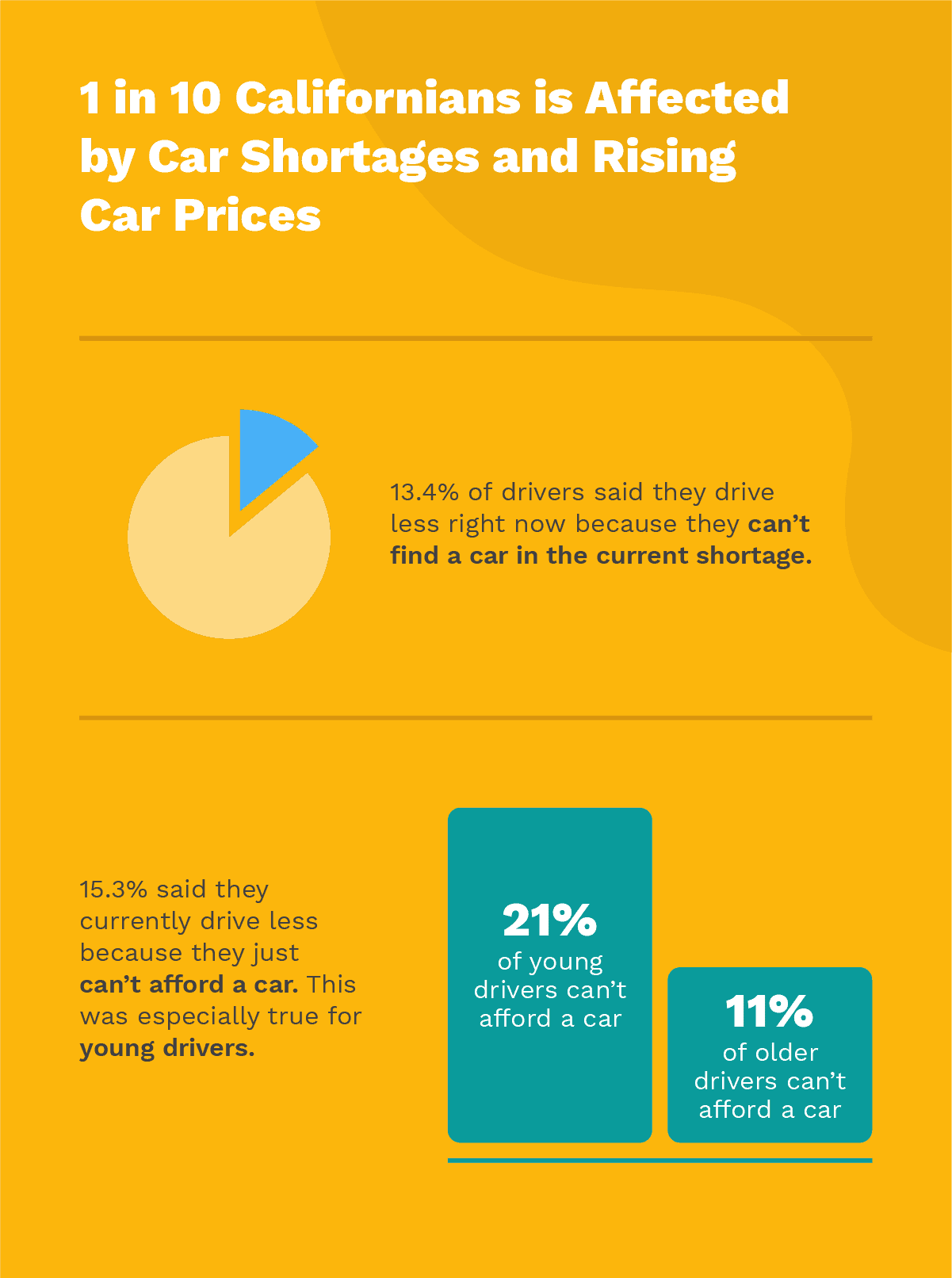
There’s been a used car shortage in the U.S. for nearly a year now. In more recent months, new cars have been in short supply, too. This is affecting Californians’ driving decisions.
13.4% of drivers said they drive less right now because they can’t find a car in the current shortage.
And as car prices skyrocket, 15.3% said they currently drive less because they just can’t afford a car. This was especially true for young drivers — 21.2% of them said they can’t afford a car right now, compared to 11.2% of older drivers.
Methodology
Using Pollfish.com, we surveyed 1,000 current California residents in late July, 2021. To proceed with the survey, respondents had to answer that they either currently drive, or have regularly driven at some point in the last five years.
Survey respondents were 46.8% male, and 53.2% female.
They were:
- 2.8% ages 16-17;
- 16.4% ages 18-24;
- 21.8% ages 25-34;
- 30.1% ages 35-44;
- 11.7% ages 45-54;
- 17.2% ages 55 or older.
